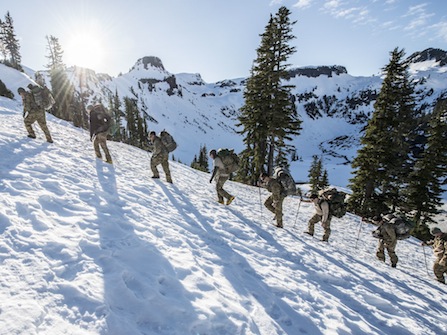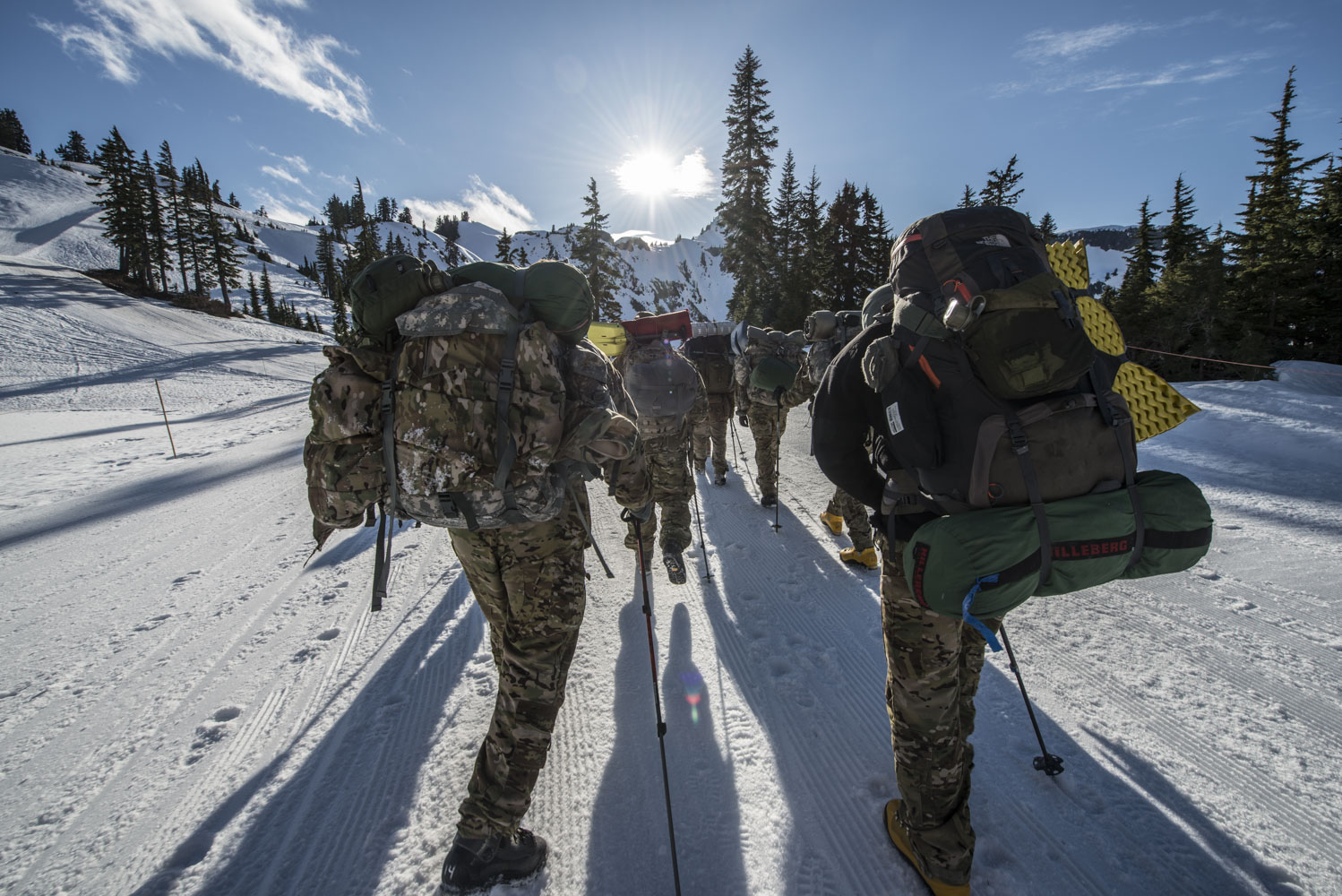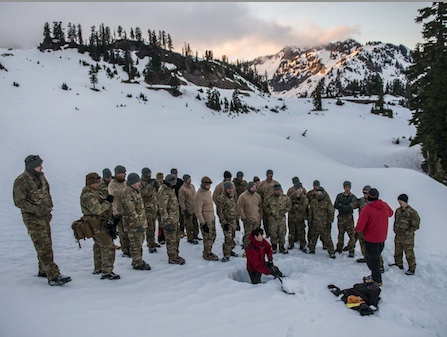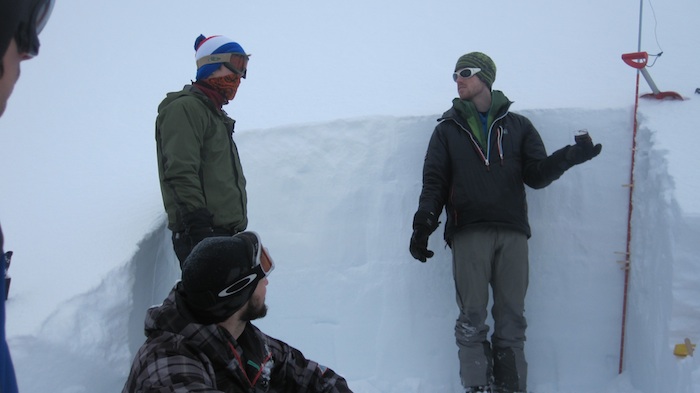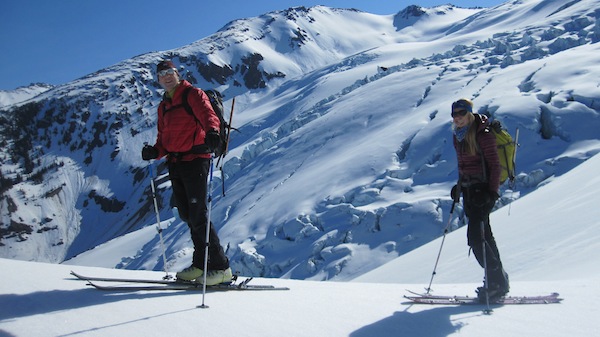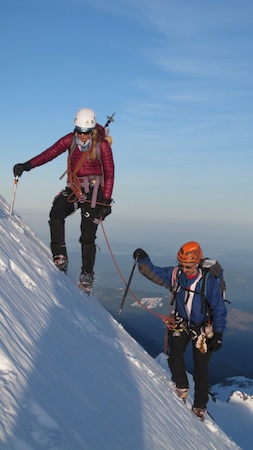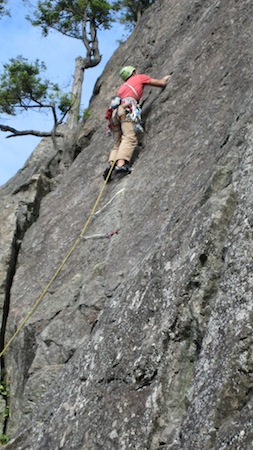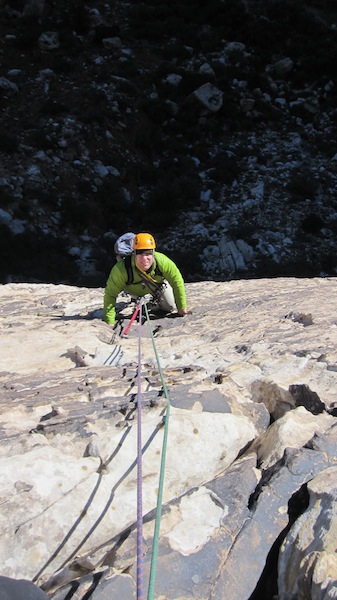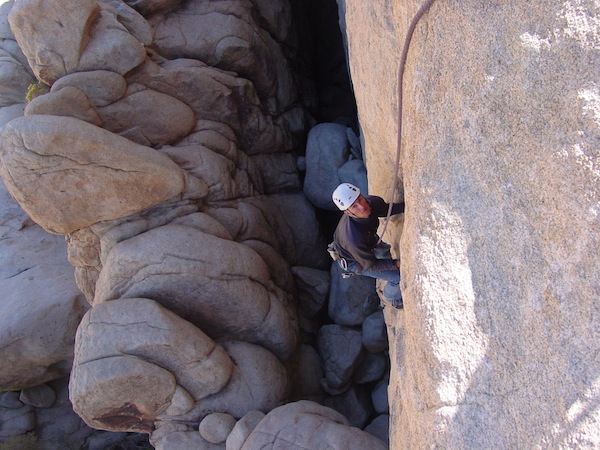Military and Government Mountain Training Overview Military, law enforcement and other government agents are often required to work in "high-end" mountain terrain to achieve their tactical objectives. These settings may require technical rock climbing, glacier mountaineering, avalanche awareness, cold weather or Arctic conditions, ice climbing or backcountry skiing. The settings may also include significant objective hazards, like avalanche terrain, icefall, rockfall, mountain weather, extreme cold or altitude. American Alpine Institute instructors and guides are equipped to train government agents in all aspects of mountain travel, hazard assessment and rescue.
Tactical training in a mountain environment. Paul Rosser
The Institute has had the privilege of working with multiple units of each of the Armed Services, including the instructors from the Marine Corps Mountain Warfare Training Center, the Air Force Weather Squadron, Navy Seals, Air Force Pararescue, Army Special Forces, Coast Guard Rescue Swimmers, and the Canadian Royal Airforce. We have trained many search and rescue groups including the Los Angeles County SWAT Search and Rescue team and a variety of volunteer SAR groups. We have also trained US Marshals in technical insertion and rescue.
Our experiences with government agents have been extremely diverse, and have provided Institute staff members with a unique understanding of what such groups both need and desire. Our program coordinators work with commanding officers to develop a curriculum that meets the specific needs of each unit while taking the unit's timeline and the unit's budget into consideration.
Custom Itineraries
American Alpine Institute program coordinators understand your need to develop a "one-size-fits-all" type course. They will work with you to find the right program location with the right features for the training that your unit desires.
The pages attached to the tabs at the top of this page will connect you to a variety of different types of programs, each with a recommended number of days. Please note that depending on your unit's previous training or lack-thereof, we may be able to shorten or lengthen the timeframe set aside for any specific lessons or curriculum.
Pricing
A climber rappels down a cliff-face at Mt. Erie, WA. Jason Martin
The pricing for this type of course varies dramatically and each program location has it's own specific costs. Mountain climbing schools tend to charge by student-to-instructor ratio. The lower the student ratio, the faster that an instructor can get through a set of information.
In addition to tuition costs, in mountain settings, like those found in the Cascades and Sierra, participants will be responsible for guide transportation and camping fees.
Following is a sample breakdown of how we might price a course. Please note that the best ratio for multi-pitch technical climbing is 1:1 or 2:1. Instructional ratios can go up to 5:1. It is possible to mix and match ratios throughout a multi-day program to bring the price down.
For the Cascades of Washington State; the Sierra-Nevada of California, and the Rocky Mountains of Colorado (per-person/day):
1:1 $700/day
2:1 $515/day
3:1 $400/day
4:1 $350/day
5:1 $325/day
Avalanche courses are less expensive due to higher ratios. Contact an AAI program coordinator for details.
Transportation and lodging are not included. Participants will be responsible for guide transportation and lodging (front country camping fees) for the duration of the course.
For Red Rock Canyon, Nevada, and Joshua Tree National Park, California:
Participants will NOT be responsible for guide transportation or lodging in these program areas.
Other Locations:
AAI has the ability to operate in several other places including -- but not limited to -- Alaska, Utah, and Wyoming. Guides may also be able to come to you to provide training on site. Please inquire for details.
Military and Government Mountain Training Curriculum There are four major components to any mountain training program. Participants may choose to incorporate one, two, three or all four of the mountain training components listed below to develop the level of training they require. Following is a breakdown of the components and an abstract of the material taught. For more information, please see the components in the tabs above.
Technical Rock Climbing
Steep mountain faces, cliffs and technical ridges exist in every mountain range on the planet. Technical rock climbing techniques are employed to both ascend and descend such features.
Rock climbing techniques taught include a wide array of skills including equipment selection, climbing movement skills, anchor building, belaying, rappelling, multi-pitch climbing, ascent and descent strategies and hazard assessment.
Technical Mountaineering
Glaciers and steep snow and ice blanket many of the world's mountains. Movement over such terrain requires a well-rounded understanding of mountaineering technique.
Mountaineering skills taught include the use of an ice axe and crampons, glacier travel, crevasse rescue, ice climbing, snow climbing, whiteout navigation, multi-pitch snow and ice climbing, snow and ice specific belay techniques, summit strategies, altitude and it's affects and hazard assessment.
Winter Travel
Winter travel in the mountains is one of the most complex things that climbers do. In addition to the normal hazards, they have to be aware of cold weather injuries, avalanches and floatation.
Winter programs have a little bit more flexibility in what is taught and need to be tailored to specific groups. In addition to the items listed under technical mountaineering, we have the ability to teach equipment selection, backcountry skiing, ski mountaineering, avalanche awareness, winter camping, expedition camp fortification, and cold weather awareness.
Rescue
There are two types of rescue, self-rescue and team rescue. Self-rescue is designed for small parties with limited equipment, while team rescue is designed for larger parties with heavier equipment. Some government or military units may wish to solely study self-rescue, whereas others might wish to work on team rescue. Choose to work on one or both styles of rescue.
Military and Government Mountain Training Rock Climbing Technical rock climbing is a broad subject. With that in mind, we have developed a four-part series for military and government agents. Please note that these four parts and their prices are simply guidelines and that we can mix and match your unit's needs with an appropriate curriculum, timeline, and student-to-guide ratio.
It would certainly be possible to stack one, two, three, or all four of these rock climbing specific programs on top of each other for a more comprehensive climbing course.
Rock Climbing for Government Agents Level I - Basic Technique (4-days)
The following curriculum has been designed with straight beginners in mind. The four-day program covers all the same material as the American Alpine Institute Basic Rock Camp .
For more information on the curriculum, please see the rock climbing itinerary download on the righthand side of the page.
Introduction to Equipment: Design, Care, Use, and Selection
Introduction to Knots and Hitches
Techniques for Belaying and Rappelling
Climbing Commands
Development of Full Repertoire of Free Climbing Technique for Moderate Ground
Introduction to both Passive and Active Traditional Protection
Anchor Construction
Techniques for Setting Up and Managing Top-Rope Sites
Rock Climbing for Government Agents Level II - Leadership (4 days)
A climber works on leadership skills in Red Rock Canyon, NV. Jason Martin
The second part of the program may be taken in tandem with the Level I program. However, it is suggested that for at least half of the program that students employ a 2:1 student-to-guide ratio.
The Level II course addresses each of the components required to safely and successfully lead a traditional rock climb. It is the same curriculum as the American Alpine Institute Learn to Lead: Traditional Rock Climbing Leadership course. Highlights include:
Care and selection of traditional climbing gear
Introduction to modern traditional technique
Anchor building techniques and management
Leader safety in both a single and a multi-pitch environment
Technical free climbing movement for a leader
Rock Climbing for Government Agents Level III - Self-Rescue (2 days)
The self-rescue component of the rock series does not address team rescue. Depending on a student's background, this program could be one or two days. The goal is for participants to demonstrate improvised rescue proficiency in a wide array of self-rescue and rock-rescue scenarios.
Self-Rescue Hauling - 2:1, 3:1, 5:1, 6:1
Pulley Systems
Load Transfers
Lowering Systems - with a munter-hitch, super-munter, tube-style device, and autoblocking device
Anchor Systems
Rope Climbing Techniques - with a friction-hitch system, with an autoblocking device, with an assisted breaking device
Belay Escapes - off an autoblocking device and off the body
Passing Knots
Multi-Pitch Descents with a Patient
Pick-Offs - patient pickoffs for self-rescue
Rappelling - classic rappel, extended rappel, tandem rappel, and counterbalance rappel techniques
Knots - figure-eight family, overhand, double-overhand-on-a-bite, bowline, double bowline, long-tail bowline, butterfly
Bends - double-fisherman's, overhand flat bend, water bend
Hitches - prusik, kliemheist, autoblock, clove, munter, and garda
Load Releasable Hitches - munter-mule
Rock Climbing for Government Agents Level IV - Aid Climbing (4 days)
A climber using direct aid to ascend a steep feature in Index, WA. Alasdair Turner
This last course is likely the least useful for military and government type individuals. Usually, you will be able to go around terrain that is so difficult and imposing that it cannot be free-climbed.
There are two reasons to consider an aid climbing course. First, there are many mountains and cliff faces throughout the world that cannot be climbed without direct aid. And second, and on perhaps a more important note, aid climbing is gear intensive. Those who aid climb really understand their gear and what it can do after climbing a handful of aid routes. This can provide an extra level of psychological security.
The aid curriculum is the exact same curriculum as that found in the American Alpine Institute Aid Climbing and Big Wall Techniques course.
Selection & use of personal equipment for an aid climb including specific ropes, harnesses, & equipment
Design concepts, selection & use of technical equipment for mixed aid & free climbing
Advanced rigging for multi-pitch climbing
Use of big wall gear & equipment including etriers, daisy chains, mechanical ascenders, haul bags, portaledges, leeper cams, hooks & an assortment of other gear
Use of fixed lines
Strategy for multi-pitch aid or mixed climbs
Strategies for multi-pitch descents
Techniques for hauling, big wall bivies, & for pendulums
Clean aid climbing techniques
Complex hauling systems
Management of hanging belays
Strategies for multi-day routes
Locations and Seasons:
Military and Government Mountain Training Mountaineering
Mountaineering is a broad term. It encompasses anything from
glacier walking to steep snow climbing, anything from ice climbing
to high altitude travel. Mountaineering skills are absolutely
essential for anyone who plans on spending time traveling in the
mountains. Baseline mountaineering skills will literally keep you
alive.
In order to meet the needs of military and government agents,
the American Alpine Institute has developed a two-part
mountaineering series. In the Level I course, we address baseline
mountaineering skills including glacier travel, snow climbing,
basic ice climbing and crevasse rescue. In the Level II course, we
address more high-end snow and ice climbing techniques, including
leadership on steep ice terrain.
The lengths of the two courses are arbitrarily based on the idea
that participants will come in with limited skills. It may be
possible to combine both courses into one shorter course depending
on an individual unit's previous experiences.
Mountaineering for Government Agents Level I (5 days)
A climber falls into a hidden crevasse. Alasdair Turner
This course is intended to serve as an intensive and complete
introduction to off-trail alpine travel, and to all the fundamental
alpine mountaineering skills of snow, ice and glacier climbing. The
course is presented on Mt. Baker in Washington State's North
Cascades, the most highly glaciated area in the lower forty-eight
states. Mt. Baker offers exposure to an unusually large variety of
landforms and climbing surfaces. '
This program covers the same snow and ice curriculum as the
American Alpine Institute Alpinism 1:
Introduction to Alpinism course.
Selection and use of personal equipment
Selection and use of ropes, knots, and harnesses
Selection and use of rock, snow, & ice anchors for belays
& intermediate protection
Belaying techniques on rock, snow, and ice
Free climbing techniques on low and high-angle snow, and
ice
Principles of glacier travel & route finding
Self-arrest; rappelling, & prusiking
The concept and application of the self-belay
Individual & team crevasse rescue techniques
Mountaineering for Government Agents Level II (5 days)
The second part of the mountaineering program will combine the
skills presented in the American Alpine Institute Alpine Ice course
with some of the skills from the AAI Denali Prep , expedition prep
course.
Participants are instructed in a highly refined, hybrid ice
climbing technique that combines the most effective aspects of
American, German, and French approaches to snow and ice.
Additionally, the course will cover altitude and expeditionary
considerations. The curriculum includes:
A climber works on ice climbing technique by climbing out of a
crevasse. Dylan Taylor
Design concepts, performance, and selection of ice axes &
technical tools
Proper choice between and application of the primary ice axe
positions: piolet canne, panne, manche, poignard, ramasse, rampe,
ancre, and traction
Choice between and application of American, French, and German
cramponing techniques
Proper selection and placement of ice screws, snow flukes &
pickets for belays and intermediate protection
The uses of mechanical belay devices in alpine climbing
Specialized designs and uses of alpine and technical tools in
high angle climbing
Free climbing technique on overhanging ice
Setting up and operating hanging belays
The uses of prusiks
Advanced crevasse rescue techniques: self-rescue, pulley
systems, and pulley system combinations
The use of skiing glissades for ease and speed of descent
Camp fortification
Altitude problems and solutions
Glacial structure and movement: using large external landforms
to predict inner glacial structures and hence the difficulties and
hazards of a potential route
Evaluation of the objective hazards of avalanche, rock fall,
and ice fall
Integration of specific skills with the general goals of
efficient, safe, and self-dependent climbing
Military and Government Mountain Training Winter Travel Winter mountaineering can be a brutal endeavor. The more efficient a team is, the more skilled they are, the less brutal winter mountain conditions tend to be.
Winter backcountry travel has a number of special problems. First, you need to have a solid baseline of mountaineering skills. A good understanding of such skills will allow for more concentration on specialty winter skills. The second problem is floatation. Is it better to use snowshoes or skis? There are advantages and disadvantages to both systems. The third problem is avalanches. To mitigate the risks of moving through the winter backcountry, you must have a solid understanding of how avalanches work and how to complete a rescue following an avalanche. And finally, the fourth problem is cold weather and how to effectively deal with it.
Avalanche Awareness
The American Alpine Institute teaches the American Institute for Avalanche Research and Education (AIARE) curriculum. This is the highest level of training available in the United States.
AIARE Avalanche Level I (3 days)
The Level I course was designed specifically for recreational backcountry travelers. It provides skiers, snowshoers, mountaineers and snowmobilers with the baseline skills needed to make good travel decisions, assess the snowpack and conduct rescues.
AIARE Avalanche Level II (4 days)
The Level II course was designed for ski patrollers, mountain guides, department of transportation crews and any other professionals that need to predict avalanches. This science-based course provides participants with the skills needed to understand how weather patterns combined with terrain and snowpack create avalanches.
Snowshoeing
Snowshoes are relatively simple. In tight treed terrain, they provide perhaps the best mode of travel. However, they are slow and can be clumsy on steep slopes.
Snowshoe training can be combined with avalanche training or with a mountaineering course.
Backcountry Skiing and Ski Mountaineering (4-9 days)
Perhaps the best way to move over snow is by using backcountry skis. These skis are specially designed so that one can ski with them uphill, then make a quick adjustment and ski back down. In open terrain your unit will be able to move very quickly on skis.
A tele-skier makes a perfect turn in the Mount Baker Backcountry. Jason Martin
An introductory ski course is aimed at developing the hard skills and techniques associated with uphill and downhill travel on alpine touring and telemark gear. Additionally, traveling in the mountains, especially in winter, requires knowledge of route finding, decision-making, terrain and snow assessment, and avalanche rescue skills.
It is recommended that participants in this program have in-bounds ski experience prior to going "out-of-bounds." If your unit does not have this, we will work with you, your unit and a local ski area to cover the material.
In each of our courses, we seek to help you develop a good working knowledge of:
Ski touring gear
Transceivers and avalanche equipment
Skiing technique
Terrain analysis for uphill and downhill track laying
Use of map and compass
Tour planning
We will also help refine personal backcountry skiing skills
Skiing on glaciers
Crevasse rescue with a ski team
Location
Ski and avalanche programs may be offered in the Washington Cascades, the Sierra-Nevada mountains of California, the San Juan Mountains of Colorado and in the Rocky Mountains of Colorado. Glacier skiing may only be offered in Washington State.
Military and Government Mountain Training Rescue There are four different levels of rope rescue, each with their own idiosyncracies. They are Rope Rescue Operations, Rope Rescue Technician, Self-Rescue, and Mountain Rescue. The American Alpine Institute can offer a rope rescue comprehensive in 14-days which covers all of these skills, or the skills can be mixed and matched:
Rope Rescue Operations (4 days)
The first level of the National Fire Protection Association (NFPA) rope rescue courses. Those who complete this course will be able to complete basic team-rescue operations in a steep-angle and high-angle environments.
Rope Rescue Technician (3 days)
Participants must have completed an Operations level course prior to entering a Technician course. This is the highest level of training dictated by the NFPA. At the end of the team-rescue course, students will be able to rig high-lines and reeving systems.
Technical Self Rescue for Climbers (2 days)
This program is noted in the rock climbing section of the Military and Government Mountain Training page. This is a program designed for independent climbers with limited gear. The ultimate goal of this program is that an injured party could escape from a multi-pitch rock climb.
Advanced Mountain Rescue (5 days)
This is a program that takes everything learned in the Operations, Technician and Self-Rescue courses and brings those skills into the mountains. The core idea behind advanced mountain rescue is improvisation. Participants should understand all components of both team and self-rescue to complete a mountain rescue objective.
Rope Rescue Comprehensive Curriculum
Students will demonstrate proficiency in both self and team-rescue on multiple terrain types, including - but not limited to - steep and high-angle rock, snow and ice.
A litter attendant hangs on a litter during a technical lower.
Team Rescue Hauling Systems - 3:1, 6:1 and 9:1
Self-Rescue Hauling Systems on Rock and on Snow and Ice - 3:1. 5:1, 6:1
Pulley Systems - simple, compound and complex
Lowering Systems - with a break rack, scarab, munter-hitch, super-munter, tube-style device, and autoblocking device
Anchor Systems - for team rescue and self-rescue on high-angle terrain, steep-angle terrain and on snow and ice.
Lowering Systems with a Litter
Use of a Guiding Line
Use of High Lines and Reeving Systems
Patent Packaging - with and without a harness
Specialized Rescue Equipment
including discussions of Class I-III harnesses, chest harnesses, rigging plates, pulleys, swivels, edge protection, and tripods
Improvised Rescue Equipment - waist and chest harnesses, improvised tri-pods and bipods, high points, and improvised anchors
Rope Climbing Techniques - with a friction-hitch system, with an autoblocking device, with an assisted breaking device
Belay Escapes - off an autoblocking device and off the body
Belays - tandem prusik belays, body belays, belay plates, mechanical belays
Passing Knots - in both a multi-pitch self-rescue setting as well as in a team rescue setting with a litter
Scene Management - command structure
Special Considerations for Mountain Rescue
Crevasse Rescue - critical procedures for team and self-rescue
Multi-Pitch Descents with a Patient in a Self-Rescue Setting
Helicopter Operations
Pick-Offs - patient pickoffs for rope rescue teams and self-rescue
Physics of Rescue Systems on Anchors and on Equipment
Rappelling - classic rappel, extended rappel, tandem rappel, and counterbalance rappel techniques
Knots - figure-eight family, overhand, double-overhand-on-a-bite, bowline, double bowline, long-tail bowline, butterfly, high tension tie-off, wrap-three-pull-two, and wrap-two-pull-one
Bends - double-fisherman's, overhand flat bend, water bend, double sheet bend, frost bend
Hitches - prusik, kliemheist, autoblock, clove, munter, and garda
Load Releasable Hitches - munter-mule and radium-release
Required Text
Technical Rescue Riggers Guide by Rick Lipke
This text may be purchased at the American Alpine Institute Shop or online.
Prerequisites
Climbers who are interested in taking the Technical Rope Rescue Comprehensive course should have experience with traditional climbing, anchors on snow and rock, mountaineering and crevasse rescue systems.
Location
Rock and team rescue portions of the program my be offered anywhere that the Institute operates. However, snow and ice skills can only be taught in the Washington Cascades, in the Sierra-Nevada mountains, in the San Juan Mountains and in the Colorado Rockies.
Program Finder
By Location
United States - Alaska
United States - Washington
United States - California
United States - Nevada
United States - Colorado
United States - Utah
Canada - British Columbia
South America - Argentina
South America - Bolivia
South America - Ecuador
South America - Patagonia
South America - Peru
Europe - Alps and Caucasus
Asia - Nepal and Tibet
Asia - Laos, Thailand, & Vietnam
Asia - China
Asia - Japan
Africa - Tanzania
Pacific and Antarctica
By Program Type
Instructional Courses
Group Summit Climbs
Expeditions
Skills Expeditions
Private Guided Programs
Treks, Tours, & Backpacking
Corporate Outings & Services
Government & Military
By Activity
Rock Climbing
Ice Climbing
Alpine Climbing
High-Altitude Climbing
Trekking and Backpacking
Skiing & Snowboarding
Guide Training & Rescue
Avalanche Training
Departure Month
Difficulty Level
Beginner
Moderate
Intermediate
Advanced
Very Advanced
x
